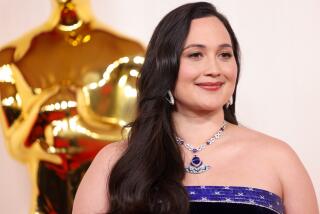New CAA study says diverse casting increases box office potential across all budgets
- Share via
There’s been little debate over the moral arguments behind increasing diversity on- and off-screen in Hollywood, but the economic arguments haven’t always been so clear.
While women, people of color, LGBTQ folk and other historically marginalized communities in Hollywood continue to insist “diversity pays,” the box office success of films with diverse casts such as “Hidden Figures” ($230.1 million worldwide) and “Get Out” ($251.2 million worldwide) is inevitably deemed a “surprise.”
A new study and database crafted by Creative Artists Agency, however, is aiming to take some of the surprise out of box office performance, noting that across every budget level a film with a diverse cast outperforms a release not so diversified.
Additionally, the data, to be released during a private leadership conference dubbed Amplify on Wednesday in Laguna Beach, demonstrates that the average opening weekend for a film that attracts a diverse audience, often the result of having a diverse cast, is nearly three times on average a film with non-diverse audiences.
One of the interesting things that the most successful movies share is that they’re broadly appealing to diverse audiences.
— Christy Haubegger
“One of the interesting things that the most successful movies share is that they’re broadly appealing to diverse audiences,” said Christy Haubegger, leader of CAA’s multicultural development group, who oversaw the study along with agency executive Talitha Watkins. “People want to see a world that looks like theirs.”
The impetus for the talent agency’s Motion Picture Diversity Index came following the release of the Motion Picture Assn. of America’s Theatrical Market Statistics report, which found that non-white moviegoers made up 49% of tickets sold in 2016, and 45% in 2015. Because the numbers outpace the 38% of the U.S. population who are non-white, CAA became interested in the audience makeup of the top-grossing films of the year. With additional data from comScore/Screen Engine’s PostTrak and Gracenote’s Studio System, the goal was to determine the correlative factors of diverse casting, diverse audiences and box office success.
CAA examined 413 theatrical films released from January 2014 through December 2016, detailing cast ethnicity for the top 10 billed actors per movie, a total of 2,800 people. They found that for the top 10 grossing movies in 2016, 47% of the opening weekend audience (and 45% in 2015) were people of color. Moreover, seven of the 10 highest-grossing movies from 2016 (and four from 2015’s top 10) delivered opening weekend audiences that were more than 50% non-white.
From there, the study notes that at every budget level, a film with a cast that is at least 30% non-white — CAA’s definition of a “truly diverse” film — outperforms a release that is not truly diverse in opening weekend box office. And on the audience side of things, the average opening weekend for a film that has a “truly diverse” audience, pegged at 38% to 70% non-white, is $31 million versus $12 million for films with non-diverse audiences.
The numbers suggest a more diverse cast brings a more diverse audience, which brings in more money.
The best-performing movie of the films evaluated, which had an approximately 40% diverse cast and a 38% diverse audience, was “Star Wars: The Force Awakens,” starring Daisy Ridley and John Boyega.
Also of note was the study’s evaluation of racial casting by genre. According to the study, the whitest genres casting-wise are horror and fantasy, and the most diverse genres are comedy and thriller.
As for what audiences want to see, white people are more likely to flock to drama and romance; black people to biopics and thrillers; Hispanics to horror and animation, and Asians to fantasy and animation.
“The hope is that seeing real numbers attached to the success of the inclusion of more voices and diverse casts will be further motivation for studios, networks and others to be really conscious of the opportunity,” said Richard Lovett, CAA’s president.
He highlighted the study as yet another way that the agency has made diversity a “moral imperative.” In the #OscarsSoWhite furor, many studios laid blame at the agencies’ collective feet.
But already in 2005, CAA began diversifying its internship pipeline by recruiting from top colleges with large black, Latino and female populations. In 2015, it created a traveling Road Show to brief film and television studios and networks on content that appeals to multicultural audiences and the availability of diverse artists working across all areas of the industry. It also continues to seek out and support diverse clients through various writing and leadership programs.
The efforts are paying off, as CAA’s revenue from multicultural clients increased 14% from 2015 to 2016, and the company was highlighted in a USC study for representing the largest share of female and African American directors.
The agency’s leadership conference Amplify is gathering multicultural artists and leaders into one space for network-building and information-sharing, with an eye to accelerating the growth of diversity trends. Some of the attendees and speakers include writer-directors J.J. Abrams and Ava DuVernay, producer Will Packer, former White House advisers Susan Rice and Valerie Jarrett, Los Angeles Clippers head coach Doc Rivers, Warner Bros. head Kevin Tsujihara, Define American founder Jose Antonio Vargas, actor-producer Kerry Washington and Stevie Wonder.
Get your life! Follow me on Twitter (@TrevellAnderson) or email me: [email protected].
ALSO:
Ava DuVernay doubles down on women directors for ‘Queen Sugar’
Netflix’s ‘GLOW,’ enters the TV ring armed with hammerlocks and female empowerment
More to Read
Only good movies
Get the Indie Focus newsletter, Mark Olsen's weekly guide to the world of cinema.
You may occasionally receive promotional content from the Los Angeles Times.











